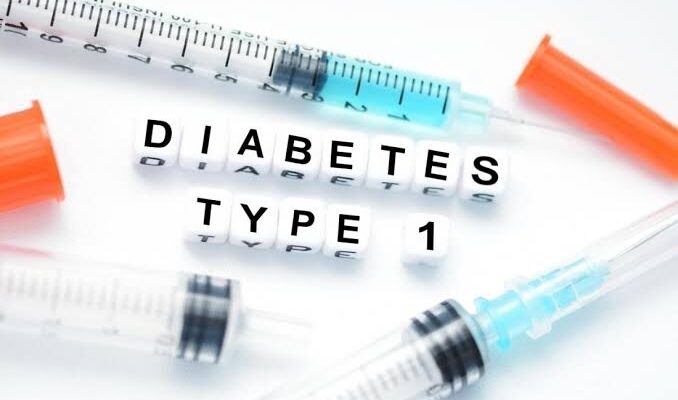Summary
Type 1 diabetes is a form of diabetes that often affects children, once commonly known as juvenile diabetes. However, it is now simply called type 1 diabetes, as the condition can develop at any age.
This condition is rare, affecting only about 5% of the population. Although less common than type 2 diabetes, type 1 diabetes is more severe. Unlike type 2, the pancreas in type 1 diabetes patients no longer produces insulin. Insulin is a hormone essential for maintaining normal blood sugar levels. Without it, blood sugar levels rise, leading to diabetes.
Symptoms of diabetes generally include frequent hunger, persistent thirst, increased urination, blurred vision, fatigue, and sudden weight loss. While these symptoms may also be present in type 2 diabetes, they tend to be more severe in type 1, and complications arise more readily.
The exact cause of type 1 diabetes remains unknown, but it is often linked to an autoimmune disorder where the body’s immune system attacks and damages its pancreas. There is also a genetic factor; children of parents with type 1 diabetes have a higher risk of developing the condition.
Table of Contents
Symptoms of Type 1 Diabetes

The symptoms of type 1 diabetes can take months or even years to appear, as the immune system gradually damages the pancreas. Once the pancreas is unable to produce insulin, the following symptoms may emerge:
- Frequent hunger. Individuals with type 1 diabetes often feel persistently hungry because blood sugar remains in the bloodstream rather than entering the muscles for energy use. As a result, glucose is not converted into energy, leading to a constant feeling of hunger.
- Persistent thirst. Studies show that high blood sugar levels cause the muscles to lose water, leading to dehydration. This dehydration makes individuals with type 1 diabetes feel thirsty frequently, as the body tries to replenish lost fluids.
- Increased urination. In an effort to lower blood sugar levels, the kidneys work harder, producing more urine to flush out excess sugar from the body. This frequent urination may lead to sugar traces in the urine, which can attract ants to undergarments or bathroom areas.
- Blurred vision. High blood sugar causes the lenses of the eyes to swell, resulting in blurry vision. This symptom may improve with blood sugar management but can become a long-term issue if blood sugar levels remain uncontrolled.
- Fatigue. As glucose remains in the bloodstream instead of entering muscles, the body lacks the energy it needs to function properly. This shortage of energy leads to fatigue and a sense of tiredness, even with minimal activity.
- Sudden weight loss. People with type 1 diabetes may experience rapid weight loss, as their muscles are not receiving adequate nutrients. Glucose stays in the bloodstream without insulin, preventing it from nourishing the muscles and converting into energy, causing unintentional weight loss.
Recognizing these symptoms early is crucial, as type 1 diabetes requires immediate medical attention to prevent complications and manage blood sugar levels effectively.
Diagnostic Procedures for Type 1 Diabetes
Diagnosing type 1 diabetes involves blood tests and assessments to confirm high blood sugar levels and determine if the body is producing insulin. Here are the key diagnostic procedures used:
- Fasting Blood Sugar Test. This test measures blood sugar levels after an overnight fast. A blood sugar level of 126 mg/dL (7.0 mmol/L) or higher on two separate occasions indicates diabetes.
- Random Blood Sugar Test. A random blood sample is taken, regardless of when the person last ate. A blood sugar level of 200 mg/dL (11.1 mmol/L) or higher suggests diabetes, especially if accompanied by symptoms like excessive thirst, frequent urination, or unexplained weight loss.
- Hemoglobin A1C (HbA1C) Test. The A1C test provides an average blood sugar level over the past 2-3 months. An A1C level of 6.5% or higher on two separate tests indicates diabetes. This test is commonly used to monitor diabetes management but can also help confirm a diagnosis.
- Autoantibody Test. Since type 1 diabetes is an autoimmune disorder, this test checks for specific antibodies in the blood that attack the insulin-producing cells in the pancreas. The presence of autoantibodies, such as glutamic acid decarboxylase (GAD) antibodies, indicates an autoimmune process, which distinguishes type 1 from type 2 diabetes.
- C-Peptide Test. C-peptide levels reflect the amount of insulin the body is producing. Low or undetectable C-peptide levels are common in type 1 diabetes, as the pancreas is no longer producing adequate insulin.
- Ketone Test. High blood sugar without enough insulin can lead to ketone production, which can cause diabetic ketoacidosis (DKA), a dangerous complication of type 1 diabetes. Urine or blood tests can measure ketones, helping confirm a diagnosis, especially in cases of severe symptoms.
These diagnostic procedures provide a comprehensive evaluation to confirm type 1 diabetes and guide the treatment approach. Early diagnosis is crucial to prevent complications and begin effective management.
Complications of Untreated Type 1 Diabetes

Without proper management, type 1 diabetes can lead to serious health complications affecting multiple organs and systems in the body. Here are some of the main complications associated with untreated type 1 diabetes:
- Diabetic Ketoacidosis (DKA). DKA is a life-threatening condition that occurs when the body produces high levels of ketones as a response to insufficient insulin. It can lead to severe dehydration, difficulty breathing, confusion, and even coma. DKA is a medical emergency and requires immediate intervention.
- Cardiovascular Disease. Uncontrolled blood sugar levels increase the risk of heart disease, high blood pressure, atherosclerosis (artery hardening), and stroke. High glucose levels damage blood vessels, making individuals more susceptible to cardiovascular issues over time.
- Nerve Damage (Neuropathy). High blood sugar can damage nerves, particularly in the extremities. Diabetic neuropathy often causes pain, tingling, numbness, or a burning sensation, most commonly in the legs and feet. Severe cases can lead to loss of sensation, increasing the risk of injuries and infections.
- Kidney Damage (Nephropathy). Prolonged high blood sugar can harm the kidneys, impairing their ability to filter waste from the blood. Over time, this can lead to kidney disease or even kidney failure, potentially requiring dialysis or a kidney transplant.
- Eye Damage (Retinopathy). Untreated type 1 diabetes can lead to diabetic retinopathy, a condition that damages the blood vessels in the retina, potentially causing blindness. High blood sugar also increases the risk of cataracts and glaucoma.
- Foot Problems. Poor blood circulation and nerve damage increase the risk of foot complications. Minor cuts or sores may heal slowly or go unnoticed, which can lead to severe infections, ulcers, and even amputation in extreme cases.
- Skin Conditions. People with untreated diabetes are more prone to skin infections, fungal infections, and itching due to poor circulation and high blood sugar, which can weaken the skin’s natural defenses.
- Gum Disease and Oral Infections. High blood sugar levels encourage bacterial growth in the mouth, increasing the risk of gum disease, tooth decay, and other oral health issues.
- Mental Health Issues. Managing diabetes can be challenging, and untreated diabetes can lead to or worsen mental health conditions like depression, anxiety, and stress. High blood sugar levels can also affect brain function, contributing to mood changes and cognitive difficulties.
- Gastroparesis. High blood sugar levels can damage the vagus nerve, which controls the digestive system. This can slow the movement of food through the stomach, leading to symptoms like nausea, vomiting, and bloating.
- Complications During Pregnancy. If type 1 diabetes is uncontrolled during pregnancy, it can lead to complications for both mother and baby, including miscarriage, preterm birth, high birth weight, and an increased risk of congenital disabilities.
Regular monitoring and management of blood sugar levels can help prevent these complications and improve quality of life for individuals with type 1 diabetes. Early intervention and consistent treatment are crucial to minimize health risks and support long-term well-being.
Causes of Type 1 Diabetes
The exact causes of type 1 diabetes are still not fully understood. However, doctors have identified several possible contributing factors:
- Autoimmune Disorder. In type 1 diabetes, the body’s immune system mistakenly attacks the insulin-producing beta cells in the pancreas. This autoimmune response gradually damages the pancreas, reducing or completely halting insulin production. Without insulin, the body is unable to regulate blood sugar, leading to type 1 diabetes.
- Viral Infection. Some studies suggest that certain viral infections may trigger an autoimmune response. Viruses, such as Coxsackievirus, mumps, and rubella, are believed to potentially cause the immune system to mistakenly attack the pancreas in some individuals. If this immune response is not controlled, it can damage the pancreas and contribute to the onset of type 1 diabetes.
- Genetics. Type 1 diabetes can also have a genetic component. Individuals with a family history of type 1 diabetes have a higher likelihood of developing the condition, as certain genes can predispose someone to autoimmune attacks on the pancreas. However, genetics alone does not guarantee that one will develop type 1 diabetes, as environmental triggers often play a role.
It’s important to note that lifestyle factors like excessive sugar consumption and lack of exercise are not causes of type 1 diabetes. These are more commonly associated with type 2 diabetes. Type 1 diabetes results from autoimmune and genetic factors rather than diet or physical inactivity.
Understanding these causes is essential for managing and researching new treatments for type 1 diabetes, as well as for identifying individuals at higher risk.
Prevention of Type 1 Diabetes
Unlike type 2 diabetes, type 1 diabetes cannot be prevented as it is primarily an autoimmune disorder or a genetic condition. However, strengthening the immune system may help reduce the risk of viral infections that could potentially trigger autoimmune responses leading to type 1 diabetes.
While managing this condition can be challenging, individuals with type 1 diabetes can still lead normal lives by taking extra precautions. Following the guidance of a healthcare provider is essential to prevent complications and maintain overall health.
Risk Factors for Type 1 Diabetes
The likelihood of developing type 1 diabetes increases due to the following factors:
- Age 14 or younger. Type 1 diabetes is commonly diagnosed in children and adolescents, making it one of the most prevalent long-term conditions affecting young people. This is why it was once called juvenile diabetes. However, research shows that adults can also develop type 1 diabetes, especially if a viral infection triggers an autoimmune response that attacks the pancreas.
- Family history of type 1 diabetes. Genetics play a significant role in type 1 diabetes risk. If one or both parents have type 1 diabetes, their children have a higher likelihood of developing the condition due to inherited genes that increase susceptibility.
- Weak immune system. Individuals with compromised immune systems are more vulnerable to viral infections, which can trigger type 1 diabetes. As mentioned earlier, certain viral infections may prompt the immune system to mistakenly attack the pancreas, resulting in the onset of type 1 diabetes.
Understanding these risk factors can help identify individuals who may benefit from early monitoring, allowing for timely intervention and management if symptoms develop.
Type 1 Diabetes FAQs
Here are answers to some common questions about type 1 diabetes, including its causes, management, and lifestyle considerations.
- What is type 1 diabetes?
Type 1 diabetes is an autoimmune condition where the body’s immune system mistakenly attacks the insulin-producing cells in the pancreas. This prevents the pancreas from producing insulin, a hormone needed to regulate blood sugar levels. - What causes type 1 diabetes?
The exact cause is unknown, but it is believed to result from a combination of genetic predisposition and environmental factors, like viral infections, that may trigger the immune system to attack the pancreas. - Can type 1 diabetes be prevented?
No, type 1 diabetes cannot be prevented. Unlike type 2 diabetes, it is not caused by lifestyle factors but rather by genetic and autoimmune factors. Strengthening the immune system and reducing infection risk may help minimize triggers, but it does not prevent the onset of type 1 diabetes. - What are the main symptoms of type 1 diabetes?
Symptoms include frequent hunger, constant thirst, increased urination, blurred vision, fatigue, and sudden weight loss. These symptoms often appear rapidly and require immediate medical attention. - How is type 1 diabetes diagnosed?
Type 1 diabetes is typically diagnosed through blood tests that measure blood sugar levels and the presence of specific antibodies, which indicate an autoimmune response against the pancreas. - How is type 1 diabetes treated?
Treatment involves daily insulin therapy, either through injections or an insulin pump, to regulate blood sugar levels. Blood sugar monitoring, a balanced diet, and regular exercise are also essential for effective management. - Is type 1 diabetes genetic?
Yes, there is a genetic component to type 1 diabetes. People with a family history of the condition have a higher risk, though not everyone with the genetic predisposition will develop it. - Can people with type 1 diabetes eat sugar?
Yes, people with type 1 diabetes can consume sugar, but they need to monitor their carbohydrate intake carefully. Managing blood sugar levels involves balancing carbohydrates with insulin doses, so it’s best to follow a dietary plan recommended by a healthcare provider. - What complications are associated with type 1 diabetes?
If not managed well, type 1 diabetes can lead to complications like heart disease, kidney damage, nerve damage, vision issues, and other serious health concerns. Proper blood sugar control can significantly reduce the risk of these complications. - Can people with type 1 diabetes live normal lives?
Yes, with proper management, individuals with type 1 diabetes can live healthy, fulfilling lives. Consistent monitoring, adhering to treatment, and making healthy lifestyle choices allow people with type 1 diabetes to achieve their goals and maintain quality of life. - Do people with type 1 diabetes need insulin for life?
Yes, because their pancreas no longer produces insulin, people with type 1 diabetes require lifelong insulin therapy to regulate blood sugar levels. - How does exercise affect type 1 diabetes?
Exercise is beneficial for overall health and can help improve insulin sensitivity. However, it requires careful blood sugar monitoring, as exercise can lower blood sugar. People with type 1 diabetes should work with healthcare providers to create an exercise plan that balances insulin and activity levels.
Type 1 diabetes can be managed effectively with the right approach, enabling individuals to lead full and active lives. For specific guidance, it’s essential to consult with healthcare providers who can tailor a plan to fit individual needs.


